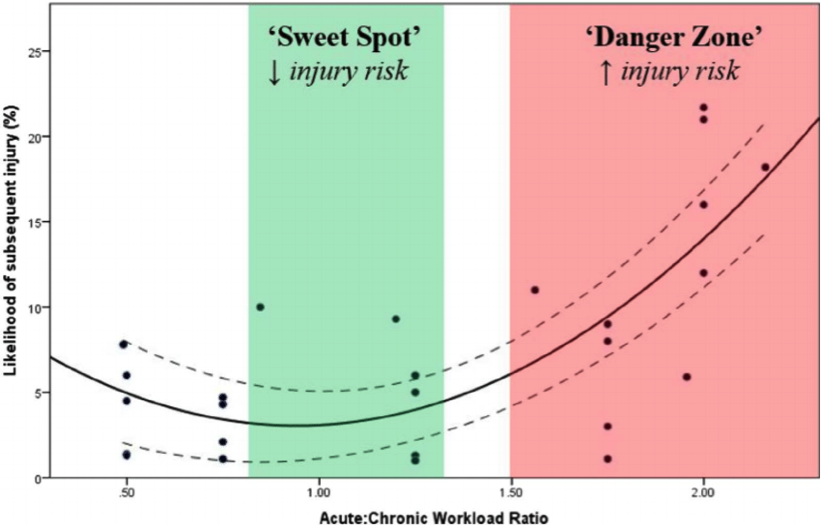Whether recovering from injury, or looking to prevent future injuries, how you manage your training load is critical. Training load is the sum of internal load factors, and external load factors.
Internal Load - the physiological stress on the body. Internal load will be influenced (positively or negatively) by factors such as age, gender, genetics, nutrition or psychological status. These factors will impact how hard or easy your body will find a workout.
You can measure the internal load your body is experiencing through subjective or objective measurements, and then track your loading over time – looking for any sudden spikes or dips in load to help predict and prevent injury.
Subjective: Through your rate of perceived exertion (RPE) rate how hard you feel you had to work through an exercise out of 10. E.g: A easy workout may be a 4/10, whereas a very hard workout would score an 8-9/10.
Objective: time spent exercising in certain percentage zones of your maximum heart rate.
Physiotherapists and rehab staff working with professional athletes will constantly monitor the internal load going through their players’ bodies by assessing both external loads (through methods like heart rate monitors lactate sampling) as well as collecting subjective information where players rate their perceived exertion after each training session. A sudden spike in one players’ reported exertion is a warning sign to staff that their internal load might be getting too high – placing them at an elevated risk of injury.
External Load- Is any eternal stimulus applied that can be measured independently of their internal load.
Eg: An AFL player who completes a running session might record total weekly running distance as his external load indicator. Alternatively, a cricketer or baseballer may use number of balls bowled/pitched.
When combined internal and external factors can be used as a measure of total training load. For example; an athlete may measure their total training load for a session through the following calculation:
Minutes exercised (external load) x rate of perceived exertion
50 minutes x 6 = 300 units of load for that session
If the athlete was to complete the same session 4 times in a week their weekly training load would be:
4 x 300 = 1200 units of training load.
The temptation when injured or when trying to prevent injury can be to reduce our load. Conceptually, this makes sense because if we reduce stress on our body then that should reduce our change of injury. However, evidence suggests that higher training loads can actually be preventative for injury as long as those higher loads are reached in an appropriate way.
Acute: Chronic Workload ratio is an indicator of how prepared your body is for a particular session. ACWR is calculated by dividing the acute training load (total load over the last week) by the chronic load (average training load completed over the last 4 weeks).
Taking the example above of an athlete who’s previous weekly load was 1200. If their average load over the last 4 weeks was 1300 then their ACWR = 0.92.
Evidence suggests that in order to prevent injury athletes should look to maintain their ACWR between 0.8-1.2 (see graph 1) to reduce their injury risk. The recommendation is that in a reloading phase an athlete should look to maintain an ACWR of 1.1 (i.e. increase their load by 10%).

Come in to see our physiotherapists or exercise physiologist who can provide advice on your injuries and help you to maintain an appropriate training load during your return to sport or as part of an injury prevention program.
STC has adapted to the COVID-19 crisis:
For those that do not need hands-on treatment or are in the vulnerable person category, we are now offering online physiotherapy and online classes, which are claimable via your health fund rebates.
We are still offering face to face physiotherapy services for those with significant musculoskeletal pain or post-surgical rehabilitation, this may change if the crisis escalates.
We are offering several classes online including Pilates and Mums & Bubs post/antenatal rehabilitation. We’re able to facilitate varied online classes, so if you’re more comfortable with conducting your rehab from home, let us know and we’ll arrange to have you dialled in online to a class.